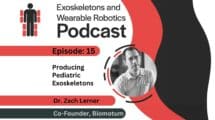Dr. Karen Nolan’s Ted Talk at TEDxHerndon from May 2016 has been finally uploaded to YouTube. In her talk, Dr. Nolan focuses on the rehabilitation needs of post-stroke patients suffering from hemiplegia. Hemiplegia is a form of paralysis on one side of the body due to brain damage from stroke.
Dr. Karen Nolan is a Senior Research Scientist in Human Performance and Engineering Research at the Kessler Foundation. You might remember her from her very persuasive and thorough presentation on the Ekso GT as a rehabilitation tool back in February 2016: Stroke Recovery Clinical Trials With Ekso GT
In her TEDxHerndon talk, Dr. Nolan spends more than half of her time focusing on the needs and challenges faced by stroke patients with hemiplegia and hemiparesis (weakness on one side). She then slowly transitions into the potential of robotics for stroke rehabilitation.
At the 11 minute mark, Dr. Nolan brings up the intensity of her talk to an 11. She presents a video segment demonstrating real world rehabilitation. She then compares the classical rehabilitation with that of a robotics device, the Ekso GT. But this is just the beginning, as Dr. Nolan is an authority on biomechanics.
Dr. Nolan dissects the usefulness of the Ekso GT rehabilitation exoskeleton beyond what can be observed by the naked eye. In her talk, she presents the muscle activations of a major muscle group with and without the exoskeleton. Furthermore, she exhibits a full 3D kinematics model of the human body with and without the use of an exoskeleton:

In the image above, you can see a person performing walking with the help of the Ekso GT. The person is moving towards the screen. The left hand is supported by a cane. Both feet are pointing in the correct direction and the step will not be executed until proper weight shift is detected by the exoskeleton.
In the image to the right, the patient is undergoing classical rehabilitation. One person is holding a cart which supports the left arm. A second person is manually moving the right leg. Note that the leg is pointing outwards. More importantly, and what would be missed by just looking at a video, there isn’t a proper weight distribution. The person is leaning on the cart with their left arm, and the right foot is being dragged along. This dramatically decreases the quality of the rehabilitation session.
Dr. Nolan concludes her presentation with a suggestion on how robotics for stroke rehabilitation can be improved. She suggests that engineers, medical professionals, patients, and researchers work more closely together. The goal of this collaboration would be to more closely define who would and wouldn’t benefit from using rehabilitation robotics. How long should the sessions be and what procedures should be followed? Amazingly, these are exactly the same challenges listed by Dr. Dylan Edwards in his June presentation at Ekso Bionics: Objective Discussion Of The Ekso GT and Adoption Challenges.
Conclusion:
In her Ted Talk, Dr. Nolan lists the now familiar primary and secondary advantages of using rehabilitation exoskeletons (more specifically the Ekso GT). She elevates the discussion by presenting videos, muscle activation graphs and 3D models of classical vs. robotic rehabilitation. This is the strongest objective argument for exoskeleton rehabilitation presented to the public so far.
Sources:
Robotics for Stroke Rehabilitation | Karen J. Nolan | TEDxHerndon, August 2016, Recorded May 2016, TEDxHerndon, NS2 National Security Services, YouTube https://www.youtube.com/watch?v=MK9AkQ2Zu_w









1 Comment